Bridge Notching Defects From Piano Manufacturers
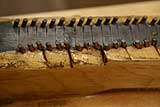
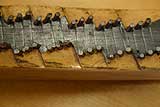
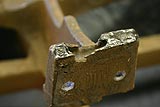
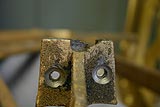
Above, we see examples of horrible piano bridge notching and poor casting
on the plate horn from a well known, high end piano manufacturer
in the mid 1970's. This is very typical of the workmanship
exhibited in piano manufacturing from the 1960's through
the 1980's. Thankfully, this kind of substandard quality
is becoming MUCH less common as current piano buyers
are wary of spending tens of thousands of dollars on
poorly made musical instruments!
|
Replacing the Patented Steinway and Sons Tubular Metallic Action Frame Rails
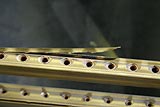
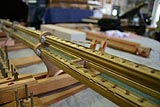
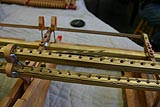
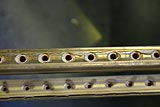
Many Vintage Steinway and Sons Grand Pianos and upright pianos exhibit
cracking and disintegrating of their patented Tubular
Metallic Action Frame rails. These rails shown are beyond
repair, and new rails will be installed to restore this
piano.
|
Piano Bridge Damage Caused by Termites
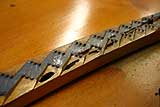
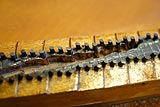
In a rare case of termite damage, we see the bridge of a 1900 era
Steinway and Sons Piano upright eaten away by these little
creatures. The damage was limited to only the bridge "cap" and
did not permeate to the core below. This damage was unknown
to us until work began on cleaning the bridge, and the
tool we used started to dive past the outer shell of
the wood, into the hollow core.
|
Cheap Repairs and Unqualified Piano Restoration Errors

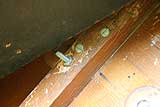

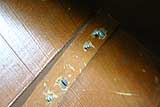
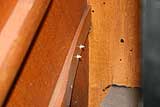
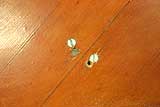
These pictures illustrate a horrible Soundboard repair performed on
a Vintage German Steinway and Sons Model O Grand Piano.
Notice the careless use of oversized screws in an attempt
to stop buzzing from Ribs that detached from the Panel
of the Soundboard. There is even a Machine bolt and nut
through one of the Ribs! This type of horrid repair is
all too common in today's quick and cheap wholesale piano
rebuilding. Needless to say, this soundboard was made
worse than before the attempted "repair."
In order to restore this piano to its former glory,
a new, Original Dimension Soundboard was produced and
duplicated to the exact standards used by Steinway and
Sons at the time the original Board was made. When completed,
the piano sounded as good as new!
|
Improper Piano Refinishing Techniques Ruined This Piano's Performance
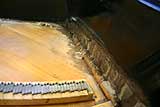
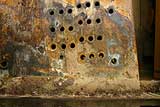
Here is a sadly poor refinishing job done in years past on a very rare
Steinway and Sons Model C Piano. The plate was not removed
before refinishing, and the stripping agent was left
to bleed into the soundboard area of the piano (above
left). Sloppy work can have deleterious effects on the
performance of a piano. On the above right, the stripping
agent was left to penetrate into the pinblock of the
piano. Needless to say, this piano soon after became
untuneable.
|
Careless Piano Refinishing With Overspray On a Keybed
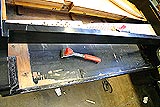



This is another example of horrid refinishing techniques on a beautiful Steinway Grand Piano. The previous refinisher carelessly left the keybed of the piano unmasked, and simply sprayed finish all over the interior of the action cavity. Needless to say, the action made a LOT of noise when the soft shift pedal was applied! The two right pictures show the cleaned and polished Keybed, ready for action frame insertion and keyframe leveling. Our completed keybed is finish sanded with 800 Grit sand paper for a glass smooth finish, which reduces drag and noise when the soft shift pedal is used.
|
Drilling a New Piano Pinblock
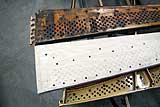
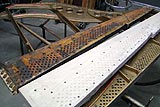
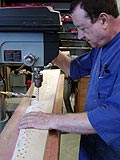 Notice the air nozzle used to cool the drill bit as
the new piano pinblock is drilled. Drill speed
selection and accuracy are crucial in maintaining uniformity
of the drilled holes, and stable tuning pin torque on
the restored piano. We also see the new pinblock versus
the old pinblock. An exact duplicate of your piano's
pinblock must be produced to achieve the best results. Notice the air nozzle used to cool the drill bit as
the new piano pinblock is drilled. Drill speed
selection and accuracy are crucial in maintaining uniformity
of the drilled holes, and stable tuning pin torque on
the restored piano. We also see the new pinblock versus
the old pinblock. An exact duplicate of your piano's
pinblock must be produced to achieve the best results.
|
Repairing Broken Piano Legs and Other Broken Piano Parts
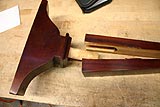
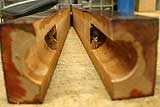
This piano leg split in two pieces as piano movers tried to set the
piano back up on its feet. Notice the clean break along
the glue joint up the center of the leg. Weak glue joints
can have disastrous effects if no one is aware of them!
Precision Piano Services will inspect for these kinds
of weaknesses during a piano restoration.
|
Manufacturer Warranty Repairs
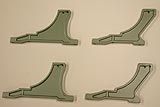 Here we see four brackets that hold together the stack
(or Frame) of a current production Korean made piano
action. These piano brackets produced through the 1980’s and 1990’s,
have a tendency to "grow" or
expand, causing the action to go out of regulation.
The only solution is to retrofit the brackets with new
stable material, and re-regulate the action. This has
been part of some the warranty repairs we have performed
for many piano makers. Here we see four brackets that hold together the stack
(or Frame) of a current production Korean made piano
action. These piano brackets produced through the 1980’s and 1990’s,
have a tendency to "grow" or
expand, causing the action to go out of regulation.
The only solution is to retrofit the brackets with new
stable material, and re-regulate the action. This has
been part of some the warranty repairs we have performed
for many piano makers.
|